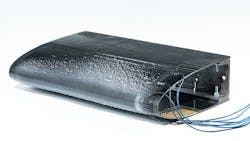German Aerospace Center developed de-icing technology using carbon fiber
"In principle, this electrical resistance heating system is similar to window heaters in cars," explains Alexander Pototzky from the DLR Institute of Composite Structures and Adaptive Systems. "High-resistance electrical conductors are fitted to the wing structure; current is then applied, which causes them to heat up. In this case, the wing structure is made of carbon fiber reinforced polymer (CFRP), which ischaracterized by its low weight and high strength."
The electrified carbon fiber solution is built into the leading edge of the wing and helps to transfer the loads acting on the leading edge. The heating structure is divided into individual heating zones, which can be controlled separately to flexibility for de-icing.
Tests on the system were conducted at the Technical Univsersity of Braunschweig in a wind tunnel that is installed in a deep freeze chamber equipped with a water injection system.
"This meant we were able to realistically re-create the conditions found during flight through a cloud, including the effects of incident flow, low temperature and droplets of moisture in the air," says Pototzky.
The impinging water that immediately freezes can either be melted or evaporated by increasing the energy input. The strategy is referred to as anti-icing, as the formation of ice on the leading edge of the wing is prevented at all times.
Ready to make a purchase? Search the Intelligent Aerospace Buyer's Guide for companies, new products, press releases, and videos
About the Author
Jamie Whitney
Senior Editor
Jamie Whitney joined the staff of Military & Aerospace Electronics in 2018 and oversees editorial content and produces news and features for Military & Aerospace Electronics, attends industry events, produces Webcasts, and oversees print production of Military & Aerospace Electronics.
